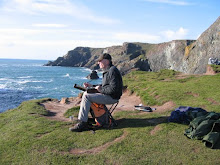
Dry Run
I remember when I first started painting outdoors and the enthusiasm which never seems to wane was as high as ever. I arrived on site and set up eager to complete an acrylic painting. The light was great, the weather fine and I was all alone in some distant field. I set up my portable studio when it suddenly dawned on me that I’d brought no water. I’d brought half decent brushes and didn’t want to take home dried out sticks so I was understandably gutted. I did manage to salvage something from the situation by painting using a knife which could be cleaned in the grass between colours, but had I done a dry run first, no pun intended, I could have avoided this pitfall.
It really pays to sit in the comfort of your home and set out what you’ll need and just as importantly what you won’t, as you’ll want to travel light. If you forget something here it is simply a case of popping back into the house and getting it. Make a small list of what it is you are using and write everything down, and I mean everything, even down to the painting gear you’ll wear. I’ve also had to improvise using the back of a sketchbook for a palette. Once you have the list it’s a good idea if you can keep one bag aside that’s ready to go or has the list in one of the pockets. I have a big rucksack that goes everywhere with me and has become part of the kit.
As a result of finding out what I wish I’d brought, if only I’d thought on, I now have a portable studio in my rucksack that is good to go in a really short time. In permanent residence l have a small hand held metal watercolour box, by Schmincke, a cardboard tube with a selection of brushes, collapsible water container, a collapsible brush holder, enamel plate for an acrylic palette a small selection of pencils, small box containing a craft knife blade, sponges, sandpaper etc and a couple of pads and primed cards, a roll of paper towel, a couple of rags and a baseball cap for the sun.
This is always in the bag but when I go out I will simply add to it, for instance my pochade box with the paints and brushes I’m using and my water or turps. I always take a large bottle of water for acrylics and watercolour, I can also drink from it too. The bag has a fishing stool attached if I choose to sit, but I always take the tripod to connect the box to should I choose to stand.
Have a go and make your own list, no two are probably the same although the basics won’t change much. I found most of my list the hard way at first, but a couple of dry runs were really worth it, so now it’s very rare indeed that I’m caught out on site… now where’s that paint I’m sure I packed it.






















